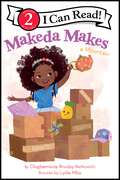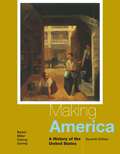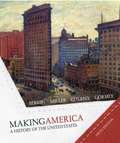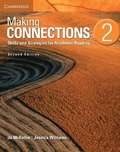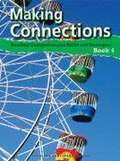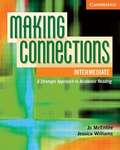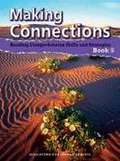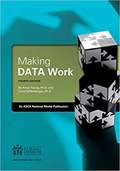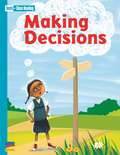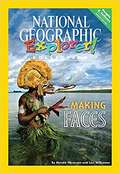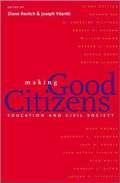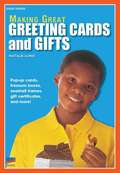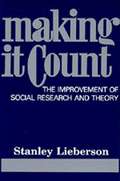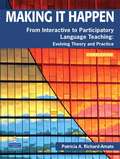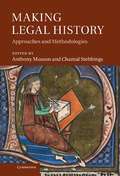- Table View
- List View
Makeda Makes a Mountain (I Can Read Level 2)
by Olugbemisola Rhuday-PerkovichThe third title in a delightful new Level 2 I Can Read! series from acclaimed author Olugbemisola Rhuday-Perkovich and illustrator Lydia Mba, starring Makeda, an exuberant seven-year-old "maker" and problem solver who loves to create. Perfect for readers who love Rosie Revere, Engineer and Reina Ramos Works It Out.Makeda and her family are cleaning the house for a party! They make a huge pile of items they don't use anymore, and soon it's time to take them away. But Makeda is not ready to throw anything out. Can she find new ways to use her old things? This Level 2 I Can Read! book features an engaging story, longer sentences, and language play perfect for developing readers.
Making A New Nation: California Vistas 5
by Jana Echevarria James A. Banks Kevin P. Colleary Walter C. Parker Emily M. Schell Stephen F. Cunha James J. Rawis Rosalla SalinasA history book set in accordance with California learning standards.
Making America: A History Of The United States
by Carol Berkin Christopher Miller Robert Cherny James GormlyShaped with a clear political chronology, MAKING AMERICA reflects the variety of individual experiences and cultures that comprise American society. The authors' goal is to spark readers' curiosity and invite them to explore and "do" history rather than simply read about it. The book conveys the surprising twists and turns as well as the individual and collective tales of success and failure that are the real story of the American past. The strongly chronological narrative, together with visuals and an integrated program of learning aids, makes the historical content vivid and comprehensible.
Making America: A History of the United States (5th edition)
by Carol Berkin Christopher L. Miller Robert W. Cherny James L. GormlyThis edition continues to thread the five central themes through the narrative of Making America that professors and students who used earlier editions will recognize. The first of these themes, the political development of the nation, is evident in the text's coverage of the creation and revision of the federal and local governments, the contests waged over domestic and diplomatic policies, the internal and external crises faced by the United States and its political institutions, and the history of political parties and elections. The second theme is the diversity of a national citizenry created by both Native Americans and immigrants. To do justice to this theme, Making America explores not only English and European immigration but immigrant communities from Paleolithic times to the present. The text attends to the tensions and conflicts that arise in a diverse population, but it also examines the shared values and aspirations that define middle-class American lives. Making America's third theme is the significance of regional subcultures and economies. This regional theme is developed for society before European colonization and for the colonial settlements of the seventeenth and eighteenth centuries. It is evident in our attention to the striking social and cultural divergences that existed between the American Southwest and the Atlantic coastal regions and between the antebellum South and North, as well as significant differences in social and economic patterns in the West. A fourth theme is the rise and impact of large social movements, from the Great Awakening in the 1740s to the rise of youth cultures in the post-World War II generations, movements prompted by changing material conditions or by new ideas challenging the status quo. The fifth theme is the relationship of the United States to other nations. In Making America we explore in depth the causes and consequences of this nation's role in world conflict and diplomacy, whether in the era of colonization of the Americas, the eighteenth-century independence movement, the removal of Indian nations from their traditional lands, the impact of the rhetoric of manifest destiny, American policies of isolationism and interventionism, or in the modern role of the United States as a dominant player in world affairs. In this edition, we have continued a sixth theme: American history in a global context. This new focus allows us to set our national development within the broadest context, to point out the parallels and the contrasts between our society and those of other nations. It also allows us to integrate the exciting new scholarship in this emerging field of world or global history.
Making America: A History of the United States (Seventh Edition) (Cengage Advantage Books)
by Carol Berkin Christopher Miller Robert Cherny James GormlyDeveloped to meet the demand for a low-cost, high-quality history book, this economically priced version of MAKING AMERICA, Seventh Edition offers readers the complete narrative while limiting the number of features, photos, and maps. All volumes feature a two-color paperback format that appeals to those seeking a comprehensive, trade-sized history text. Shaped with a clear political chronology, MAKING AMERICA reflects the variety of individual experiences and cultures that comprise American society.
Making Connections (Second Edition): Level 1 : Skills and Strategies for Academic Reading
by Jessica WilliamsMaking Connections teaches an extensive range of reading skills and strategies in order to prepare students for college reading. <P><P>Making Connections Second edition Level 1 Student's Book introduces first-time readers of academic text to basic reading strategies such as finding paragraph topics, finding supporting details and learning to read quickly.<P> It features a variety of high interest topics including national borders, names, food, sleep, natural disasters, and music.
Making Connections 2: Skills and Strategies for Academic Reading, 2nd Edition
by Jo McentireMaking Connections teaches an extensive range of reading skills and strategies in order to prepare students for college reading. Making Connections Second edition Level 2 Student's Book introduces fundamental reading skills and strategies such as identifying main ideas, interpreting information in charts and graphs, and preparing for reading tests. It features a variety of high-interest topics including news media, education, global business, population growth, fashion and design, and the brain.
Making Connections Book 4
by Kay Kovalevs Alison DewsburyAdvance vital reading comprehension skills through a balance of appealing nonfiction and fiction titles, focus on strategies and skills critical for reading comprehension, and nonfiction features such as indexes, glossaries, tables of contents, and captions.
Making Connections, Intermediate Student's Book: A Strategic Approach to Academic Reading and Vocabulary
by Jessica Williams Jo McentireMaking Connections Intermediate is a reading skills and strategies book that prepares students for college-level reading. It has six high-interest thematic units, each with multiple readings. The readings are written in an accessible academic discourse style, providing practice for intermediate-level students who will eventually need to access authentic academic text.
Making Connections: Book 5
by Kay Kovalevs Alison DewsburyAdvance vital reading comprehension skills through a balance of appealing nonfiction and fiction titles, focus on strategies and skills critical for reading comprehension, and nonfiction features such as indexes, glossaries, tables of contents, and captions.
Making Connections: Foundations for Algebra, Course 2, Version 3.0
by Leslie Dietiker Jonathan Weast Barbara ShreveNIMAC-sourced textbook
Making DATA Work
by Ph. D. Anita Young Carol KaffenbergerMaking DATA Work: An ASCA National Model Publication
Making Faces (Fountas & Pinnell Classroom, Guided Reading)
by Marthe JocelynNIMAC-sourced textbook. Fun with Faces. It's easy to make a face. All you need are scissors, glue, and some paper. Now let's get started!
Making Faces, Pathfinder Edition (National Geographic Explorer Collection)
by Ronald Naversen Lori WilkinsonNIMAC-sourced textbook
Making Faces, Pioneer Edition (National Geographic Explorer Collection)
by Ronald Naversen Lori WilkinsonNIMAC-sourced textbook
Making Good Citizens: Education and Civil Society
by Diane Ravitch Joseph P. ViterittiLeading thinkers from a variety of disciplines probe the relation between a healthy democracy and education. Contributors such as Jean Bethke Elshtain, Nathan Glazer, Robert Putnam, Jack Rakove, and Alan Wolfe discuss topics that range from the place of religion in public life to political conflict in a pluralist society to the problems of racial inequality.
Making Great Greeting Cards and Gifts
by Natalie Lunis Alison Adams Albert HannerFind out about how to make greeting cards and gifts using various materials.
Making It Count: The Improvement of Social Research and Theory
by Stanley LiebersonThere were many failures before humans successfully learned to fly. After watching birds flap their wings, bold and adventurous individuals built huge winglike structures, leaped off cliffs, flapped their wings vigorously, and broke their necks. There are principles of flight to be learned from watching the birds all right, but the wrong analogy had been drawn. In similar fashion, our empirical approach to social behavior is based on an analogy.
Making It Happen, from Interactive to Participatory: Language Teaching, Evolving Theory and Practice (4th Edition)
by Patricia A. Richard-AmatoNew to this edition: Separate chapters on implicit/explicit teaching and on a sociocultural/cognitive synthesis. New sections on focus form strategies, World Englishes, research directions, corpus analysis, dialogical assessment, and the Acoma heritage language program. The research has been updated throughout and reflects influential thinking for the 21st century. Part 1: Theoretical Considerations - Explores current theory and research; builds a case for emergent participatory teaching; and highlights literacy development, self-directed learning strategies, and current assessment issues and practices. Part II: Exploring Methods and Activities - Presents a practical reservoir from which teacher can draw as they develop their own methodologies and local practice. Part III: Putting It All Together: Some Practical Issues - Considers issues critical to program development, lesson design, textbook and computer program selection, video use; teacher research and professional development (including SOP). Part IV: Programs in Action - Describes K-Adult Programs (ESL, Foreign Language, Bilingual, and Tribal Heritage). Part V: Case Studies: Teacher Narrations to Stimulate Professional Dialogue - Presents case studies, ranging from kindergarten through university levels.
Making Legal History
by Chantal Stebbings Anthony MussonDrawing together leading legal historians from a range of jurisdictions and cultures, this collection of essays addresses the fundamental methodological underpinning of legal history research. Via a broad chronological span and a wide range of topics, the contributors explore the approaches, methods and sources that together form the basis of their research and shed light on the complexities of researching into the history of the law. By exploring the challenges posed by visual, unwritten and quasi-legal sources, the difficulties posed by traditional archival material and the novelty of exploring the development of legal culture and comparative perspectives, the book reveals the richness and dynamism of legal history research.
